1970 Ford Mustang Boss 302
In the realm of American muscle cars, few vehicles have left as lasting an impression as the 1970 Ford Mustang Boss 302. Born out of fierce competition on the racetrack, this iconic pony car is celebrated for its combination of raw power, striking design, and exceptional handling. Let’s delve into the history and legacy of the 1970 Ford Mustang Boss 302, a true legend in the world of automotive performance.
A Legacy of Racing Excellence
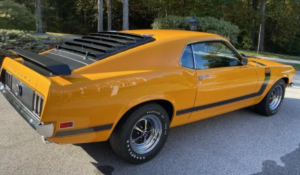
The Boss 302 was not just another Mustang variant; it was a product of Ford’s desire to dominate the Trans-Am racing series. In order to compete with the likes of Chevrolet’s Camaro and American Motors’ Javelin on the track, Ford’s Special Vehicle Team (SVT) set out to create a high-performance Mustang capable of taking on its rivals.
Under the leadership of legendary engineer Larry Shinoda, the Boss 302 was born. The name “Boss” was a nod to the boss of Ford’s racing program, Bunkie Knudsen, and it was clear from the outset that this Mustang was designed for one purpose: to win races.
Heart-Pounding Power

At the heart of the 1970 Boss 302 was its namesake engine, the 302 cubic inch V8. This engine was a high-revving powerhouse, producing 290 horsepower and 290 lb-ft of torque. What set the Boss 302 apart was its unique “canted valve” cylinder heads, which allowed for improved airflow and higher RPMs.
To ensure that the Boss 302 was a competitive force on the track, Ford equipped it with a close-ratio 4-speed manual transmission and a Hurst shifter. Additionally, the car featured a high-performance suspension, a front spoiler, and rear window slats, all designed to enhance its aerodynamics and stability at high speeds.
Striking Design and Signature Styling
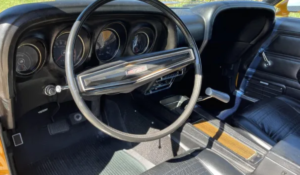
The 1970 Boss 302 featured a distinctive exterior design that made it instantly recognizable. It sported bold graphics and distinctive striping that ran along the sides and over the roof, highlighting its racing pedigree. The front end of the car was adorned with a blacked-out grille and a prominent Boss 302 badge.
One of the most iconic elements of the Boss 302’s design was its “Shaker” hood scoop. Unlike many decorative scoops of the time, the Shaker scoop was functional, moving up and down with the engine’s vibrations, allowing for cooler air to be drawn into the carburetor. It was not only a design statement but also a testament to the car’s performance-oriented engineering.
Race-Ready Interior

Inside the Boss 302, the focus on performance continued. The car featured a simple yet purposeful interior with high-back bucket seats, a wood-grain dashboard, and a three-spoke steering wheel. A signature “Rim-Blow” steering wheel, which allowed drivers to honk the horn by squeezing the wheel, was also available as an option.
While the interior was functional and driver-focused, it didn’t compromise on comfort. The high-back bucket seats provided excellent support during spirited driving, and the cabin offered a pleasant environment for long journeys.
On the Track and Beyond
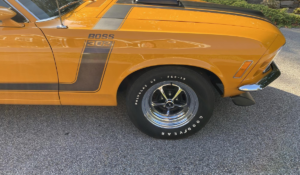
The Boss 302 made an immediate impact on the Trans-Am racing circuit, winning the championship in its debut year in 1970. Parnelli Jones, a racing legend, piloted the Boss 302 to victory in the season, cementing its reputation as a formidable racing machine.
Beyond the track, the Boss 302 captured the hearts of enthusiasts and collectors alike. Its combination of power, handling, and distinctive design made it an instant classic. The Boss 302 also had a significant influence on the Mustang lineup, inspiring subsequent generations of high-performance Mustangs and special editions.
Collectibility and Legacy
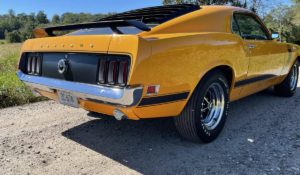
Today, the 1970 Ford Mustang Boss 302 is a highly sought-after collector’s car. Its rarity and racing pedigree have made it a prized possession for enthusiasts, and its value has continued to appreciate over the years. Finding one in excellent condition is a testament to the dedication of collectors and restorers who preserve these iconic vehicles for future generations.
The Boss 302’s legacy extends beyond its status as a classic muscle car. It represents an era when American automakers pushed the boundaries of performance and design, creating vehicles that embodied the spirit of competition and the thrill of the open road. The Boss 302 remains an enduring symbol of that era and continues to inspire a new generation of car enthusiasts.
Conclusion
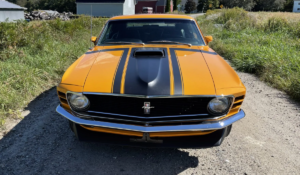
The 1970 Ford Mustang Boss 302 is not just a car; it’s a symbol of American muscle car excellence. Its powerful engine, distinctive design, and championship-winning pedigree have earned it a special place in the hearts of automotive enthusiasts. Whether you’re a collector, a racer, or simply an admirer of automotive history, the Boss 302’s legacy is undeniable.
As we look back on the golden age of muscle cars, the Boss 302 stands as a reminder of the innovation and excitement that defined that era. It represents a time when cars were not just modes of transportation; they were expressions of power and performance. The Boss 302, with its racing heritage and unmistakable style, will forever be a testament to the enduring allure of American muscle cars.


